Hydrogeology of volcanic islands by Tatiana Izquierdo

Groundwater is the main water resource in Tenerife (Canary Islands) where it represents almost 90... more Groundwater is the main water resource in Tenerife (Canary Islands) where it represents almost 90% of the consumption. For the Insular Hydrological Plan the most important aquifer in the future will be the one located in Las Cañadas which belongs to the III Hydrogeological Zone. For exploiting this aquifer in a rational way in the future it is necessary to know and assess carefully the recharge estimates. It is for this reason, that the choice of the rainfall interpolation method is so important. In this study three different interpolation methods have been used to compare their results with the real data of the gauges and to obtain doing that, the best precipitation estimate in the area. The results show the ordinary kriging to be the best interpolation method in the study area and that the use of the relationship between elevation and precipitation do not increase the accuracy of the interpolation even though the climatic characteristics of the island have been taken into account.
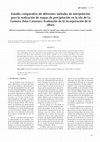
Geogaceta, Jan 1, 2007
Groundwater is the main water resource in La Gomera (Canary Islands) where it represents almost 7... more Groundwater is the main water resource in La Gomera (Canary Islands) where it represents almost 70% of the consumption. Since the elaboration of the preliminary works of the Insular Hydrological Plan in 1996 there has not been other estimation of the island's rainfall. For an accurate estimation of the future hydrogeological resources of the island it is necessary to know and assess carefully the recharge estimates. It is for this reason that the choice of the rainfall interpolation method is so important. In this study two different interpolation methods have been used to compare their results with the real data of the gauges and to obtain doing that the best precipitation estimate in the area. Results show the kriging with external drift to be the best interpolation method in the study area and that the use of the relationship between elevation and precipitation increase the accuracy of the model.
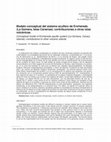
Estudios …, Jan 1, 2011
La elaboración de modelos conceptuales en acuíferos de islas volcánicas presenta una elevada difi... more La elaboración de modelos conceptuales en acuíferos de islas volcánicas presenta una elevada dificultad debido a la complejidad estructural de los materiales volcánicos, incrementada por 1) los procesos de destrucción (p. ej., deslizamientos de flanco) y 2) la intrusión de diques, que pueden actuar como zonas de flujo preferente o sobreelevando el agua localmente. En algunos casos, la falta de información hidrogeológica en el interior de las islas dificulta aún más la caracterización del funcionamiento de los acuíferos en estas zonas. En este trabajo se evalúa el papel de los diques y de los depósitos volcanoclásticos en el flujo regional de la zona de Enchereda (La Gomera, Islas Canarias) y en particular, en su zona más elevada. En esta zona se definen tres unidades hidroestratigráficas: los Basaltos Antiguos Inferiores moderadamente permeables; a techo las Brechas Volcánicas de baja permeabilidad; y por encima los Basaltos Antiguos Superiores, permeables. Las brechas parecen actuar como límite inferior impermeable del acuífero y en su reconstrucción se observa que presentan una geometría coherente con un buzamiento general hacia el ESE de aproximadamente 13º, condicionando el flujo regional del agua en el acuífero. La cartografía de los diques mediante fotografía y ortofotografía aérea así como en campo y en el interior de la galería de Ipalán, ha permitido identificar cuatro familias de diques. Los diques NO-SE son los más abundantes, con una densidad máxima de más de 10 diques/100 m, similar a otras zonas de rift en volcanes oceánicos. Estos diques son paralelos al flujo regional del agua en el acuífero y actuarían por tanto como zonas de flujo preferente, mientras que los diques con direcciones N-S y NE-SO sobreelevarían el nivel piezométrico, generando una superficie escalonada, al ser perpendiculares a la dirección flujo. Por último, los diques E-O parecen influir en menor medida en el acuífero. Nuestros resultados plantean la necesidad de reevaluar principalmente la influencia de los diques en el flujo regional de acuíferos en otras islas volcánicas en las que su papel se ha minimizado, ya que la superposición de diferentes familias de diques puede condicionar el movimiento del agua en el acuífero.
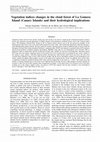
Hydrological …, Jan 1, 2011
Vegetation indices derived from remote sensing data still remain to be used for analysing the rel... more Vegetation indices derived from remote sensing data still remain to be used for analysing the relationship between climatic factors and vegetation seasonal phenology in middle latitudes with subtropical conditions forests such as the Canarian laurel forest. The Garajonay National Park, located in the La Gomera Island, protects one of the best preserved examples of the Macaronesian laurel forest, due to the cloud banks produced by trade winds, with rainfall and temperature field data showing a clear Mediterranean climatic pattern. We have analysed seasonal vegetation indices trend for different types of forest inside the Garajonay National Park using normalized difference vegetation index (NDVI) and enhanced vegetation index (EVI) products derived from moderate resolution imaging spectrometer (MODIS) Aqua data for two hydrological years (October 2003 to September 2005 in relationship with the existing field climatic data: rainfall, net fog water and temperature. Maximum annual EVI maps show the highest vegetation indices in the laurel forest of La Gomera that occur during the dry season, mainly in late spring to early summer, with EVI temporal profiles showing that valley-bottom laurel forest areas have the most clear seasonal trend. Difference maps of EVI values between months with the lowest and highest rainfall of each hydrological year clearly confirm the highest photosynthetic activity in the laurel forest during the dry season. In addition, these forests show a significative temporal correlation between EVI values and the temperature in the forest (p < 0Ð001). Our results prove the absence of summer drought stress in the laurel forest implying that the fog drip income is high enough to maintain enough soil moisture to allow the forest fully transpire when temperatures are higher. As the laurel forest of La Gomera occurs in the main recharge area of the island's aquifer system, our analysis of EVI data suggests that fog drip constitutes a key hydrological factor.

Catena, Mar 2014
Conceptual groundwater models in volcanic island aquifers remain an issue in many regions of the ... more Conceptual groundwater models in volcanic island aquifers remain an issue in many regions of the world. This study takes advantage of the large number of outcrops exposing the inner structure of La Gomera (Canary Islands), due to its inactivity during the last 2.5 Ma, to develop a conceptual groundwater model that helps improving groundwater resource management in the island and increasing knowledge in volcanic aquifers. Based on a volcanostratigraphic model, five hydrostratigraphic units have been defined that include two main aquifers and volcaniclastic deposits located between them that control the vertical movement of the groundwater. The island has been classified into four aquifer systems or water management units based on their hydrogeological features that permit a sustainable and independent management of the resources of one aquifer system in relationship with the other ones. The consideration of the complexity and heterogeneity of La Gomera geology has allowed to develop a conceptual groundwater flow model and to identify four general groundwater situations: 1) groundwater in the Upper aquifer discharging to the sea; 2) groundwater in the Upper aquifer springing out along the main ravines; 3) groundwater in the Basal aquifer impounded by dikes and; 4) groundwater in the Basal aquifer discharging to the sea.
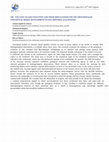
Conceptual models in volcanic island aquifers remain an issue in many regions of the world, as us... more Conceptual models in volcanic island aquifers remain an issue in many regions of the world, as usually, little hydrogeological information is available about these areas. This research evaluates the influence of the geological evolution of San Cristóbal (558 km2, Galápagos archipelago) in its aquifers and springs using classical field geological methods combined with a 3D resistivity model. The subaerial basaltic volcanism of the island (2.35±0.03 to 0.66±0.08 My) formed in the southwestern region, an older large shield volcano (710 masl), and a younger flat region to the northeast. The study area is located in the windward slope of the inhabited southwestern region, exposed to the tradewinds, where the only permanent springs of the archipelago are present. The field description of the outcrops includes exposure conditions, geological material and weathering degree as well as any other relevant geological or hydrogeological observations. These features allow us to classify the outcrops by their weathering degree and to identify a spatial differentiation of more or less permeable areas. In the eastern sector of the studied area, outcrops appear more altered/weathered whereas in the western sector lava flows still show their primary structure. The geophysical data obtained during the electromagnetic survey with the SkyTEM heli-born device reveals the existence of: (i) one or several shallow aquifers, where groundwater flows southwards and intersects the topography at several points that correspond to observed springs; and (ii) a deeper aquifer showing a southwestern flowpath. We consider that, the alternation of eruptive and calm periods in the island has developed a complex multi-layered aquifer in which non-weathered lava flows, weathered lava flows and paleo-soils are intercalated. Therefore, even though the geological evolution of San Cristóbal is relatively simple, the different hydrogeological features of these materials give as a result a heterogeneous and anisotropic aquifer with permeability values that should be studied in the future.
Sea-level and climate change by Tatiana Izquierdo
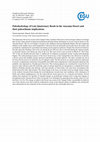
The Quaternary fluvial succession in the Copiapó Valley (northern Chile) have not been deeply stu... more The Quaternary fluvial succession in the Copiapó Valley (northern Chile) have not been deeply studied even though they record a large amount of palaeoenvironmental and paleoclimate information in an area of great interest as the Atacama Desert. The city of Copiapó is located at the confluence between Quebrada Paipote (the most important tributary of the middle course) and Copiapó River which has been dry during the last decades due to the surface and groundwater exploitation for agricultural and mining activity purposes upstream. Despite that, historical chronicles describe numerous flooding events in the city during the last 400 years due to snowmelt during the summer months or unusually intense rains during any time of the year. The most recent event occurred on March 25, 2015 when 70% of the city flooded and more than 2.2 million m3 of sediment accumulated, mostly coming from Quebrada Paipote. The sedimentological analysis of the lower fluvial terrace of the Copiapó River has allowed us to identify a fluvial system that abruptly changes upward to paleoflood and aeolian deposits. The latter constitute the top of the lower fluvial terraces on which the city of Copiapó is built. The fluvial facies are mainly formed by imbricated to massive conglomerates and poorly sorted pebble and cobble sized conglomerates with laminated sandstones that probably were deposited in a braided gravel-bed river. The overlying deposits are constituted by several levels of massive sandy siltstones and well sorted fine sands of aeolian origin that are interpreted as overbank flood events linked to flooding episodes that alternate with long episodes of eolian dunes and sand sheets development that buried almost the entire alluvial plain. This sharp change in the facies association record an abrupt climate change in the southern Atacama Desert during the recent Quaternary towards more arid conditions, with a dominance of floods and aeolian morphogenesis over the typical fluvial system processes in a semiarid environment. Several authors have proposed two episodes of regional changes in groundwater recharge tied to long-term changes in precipitation in the Atacama Desert when wet periods were terminated by pronounced dry periods, from 9 to 8 ka and from 3 to 0 ka. The change recorded in the fluvial succession of the Copiapó Valley can probably be linked to one of this climate event what would be confirmed by means of the deposits dating. In addition, this will provide more information for the estimation of the recurrence period for this catastrophic processes.
The first human settlements (6000−4000 BP) in the early estuary of the Tinto and Odiel rivers wer... more The first human settlements (6000−4000 BP) in the early estuary of the Tinto and Odiel rivers were located in the ancient coastal banks or in the nearby hills. From 4000 years BP onwards, the estuarine sediments started to emerge as sand barriers and chenier plains, prograding towards the mouth. As the littoral strands stabilized morphologically, they are colonized by human settlements in successive periods, the oldest inland (Almendral) and more recent outward (Cascajera). These emerged morphologies were surrounded by muddy tidal flats in the estuary and only the high-energy marine events such as a tsunami or extraordinary storms were able to modify both the landscape and human settlements installed on them. This work also describes the morphodynamic model that built the chenier plain of La Cascajera.
Geogaceta, May 2012
We describe a Quaternary succession consisting of coastal and teuvestrial facies which record sea... more We describe a Quaternary succession consisting of coastal and teuvestrial facies which record sea level fluctuations in the Eastern coast of Bahoruco peninsula (SW of Dominican Republic). The bottom of this sequence is formed by coral limestone deposit interpreted as fringing reef with a most likely age corresponding to the onset and progress of Last Interglacial (132-120 kyrago). This deposit is covered and eroded by rampant dunes and alluvial fans that recorded a rapid sea-level drop. A very similar sequence of facies have been described by several authors in the Bahamas and other Caribbean areas, showing rapid and abrupt sea-level fluctuations that occurred within the beginning of Marine Isotope Stage 5.
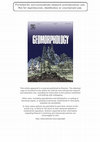
Geomorphology, Jan 1, 2013
The Last Interglacial is considered the most suitable episode from which to infer patterns of rap... more The Last Interglacial is considered the most suitable episode from which to infer patterns of rapid sea-level change since its climatic conditions were similar to those of the present interglacial. However, specifying the true position of its sea level with high accuracy is very troublesome in the absence of sedimentological, erosional or even palaeontological markers. This study investigates the morphosedimentary evidence (beach deposits, cliff, notch and shore platform) of two highstands registered and dated during MIS 5 stage by U-series dating in the North of Morocco (Strait of Gibraltar). Bioerosive notches and mixed siliciclastic and carbonate deposits, high energy beaches with algal bioherms, were formed in coastal environments during MIS 5a. A sea-level height of + 10 m asl can be inferred for this substage. The record of MIS 5e substage is less defined in the geomorphological record, consisting of backshore/foreshore deposits located at + 13 to + 15 m asl. A tectonic uplift rate of ~ 0.1 mm/yr has been estimated for the last 130 kyr. These data are consistent with models of coastal uplifting calculated for the Strait of Gibraltar.► Morphosedimentary evidence of MIS 5 highstands are recorded in the North of Morocco. ► Bioerosive features and high-energy beach facies were formed during MIS 5e and MIS 5a. ► A low tectonic uplift rate of 0.1 mm/yr has been estimated for the last 130 kyr. ► A phase of hydro-isostatic subsidence at the end of highstands cannot be rejected. ► Our data are consistent with models of coastal uplifting elaborated for the Strait of Gibraltar.
Volcanology by Tatiana Izquierdo

Global and Planetary Change, 2018
Rift zones are fundamental features in oceanic island volcanoes, although their origin is still c... more Rift zones are fundamental features in oceanic island volcanoes, although their origin is still controversial, especially at the Canary Islands where the role of volcanic spreading is under debate. For this reason, we have performed a field study of > 400 dykes at 20 outcrops in the Lower Old Edifice and 2 outcrops of the Upper Old edifice of La Gomera Island, identifying different dyke swarms. We propose the development of an unnoticed E-W volcanic rift (Hermigua Rift) restricted to the Lower Old Edifice East flank, with up to 25% of extension and structural characteristics compatible with the spreading of the edifice over a basal weak decollement. Contemporaneously a dyke swarm of outward-dipping dykes intruded at the W-SW zones, indicating a progressive radial sliding of the edifice. This asymmetric volcano structural pattern suggests that volcano stresses were predominately local in origin, probably related to the buttressing effect of the neighbor contemporaneous Roque del Conde edifice (Tenerife Island). Additionally, we have deduced two different rift zones (NW-SE Enchereda and N-S Erque rifts) during the growth of the Upper Old Edifice, evidencing that La Gomera rifts were dynamic evolving structures. The structure and regional setting of the Upper Old Edifice rifts suggest a change to a predominance of regional stresses. Our results have implications for the understanding of the origin and evolution of rifts at oceanic island volcanoes, since: 1) confirm a principal role for volcanic spreading processes; 2) support that the location of neighbor volcanic loads strongly influences rifts development; and 3) suggests, in some situations, a possible main role for the regional stress field.
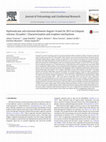
Journal of Volcanology and Geothermal Research, 2017
Cotopaxi is an active, hazardous and ice-covered stratovolcano 60 km southeast of Quito, (Ecuador... more Cotopaxi is an active, hazardous and ice-covered stratovolcano 60 km southeast of Quito, (Ecuador) whose last major eruption occurred in 1877. During 2001–2002, volcanic unrest characterized by volcanic seismicity and deformation ended without eruptive activity. On April 2015, a new increase of seismicity, SO 2 emissions, thermal anomalies and edifice deformation, evolved into the onset of a new eruptive cycle, beginning August 14. We sampled and measured the ash fall deposits to the west of Cotopaxi between August 14 and 24, 2015. The ash collected was analyzed using grain size, X-Ray fluorescence, X-Ray diffraction and scanning electron microscope (SEM-EDS), revealing the eruptive products to be compound of dense fragments (mostly lithics), diverse types of scoria, pumice, free fractured crystals, glassy particles and aggregates. Most of hydrothermal alteration is observed during the initial stage of the eruption (14–15 August; including Cu oxides and Fe minerals in the lithics). The glassy particles were blocky morphology, and textural changes were recognized over 10 days of eruption, varying from null or low vesicularity to low-to-moderate vesicularity, occasionally exhibiting molten or subrounded textures. The bulk ash has a basaltic-andesitic composition (~55.67 wt% of SiO 2), while clusters of selected particles (likely juvenile) analyzed through SEM + EDS reveal dacitic composition (65.67 and 65.8 wt% SiO 2). Plagioclase, clinopyroxene and orthopyroxene are the main minerals present, with accessory anhydrite, melanterite and py-rite (these typically observed during the initial stage of eruption). These variations in addition to the geophysical background, led us to interpret this eruption as the result of the volcano's hydrothermal system disruption due to a shallow, low-volume magma input, which initially evolved into phreatic activity at surface level. Further activity up to 24 August was triggered by the indirect interaction between magma and the depleted hydrothermal system , generating a magmatic-hydrothermal eruption. The issue is important for evaluating unrest periods at active stratovolcanoes, and the impact of their initial, low-volume ash falls in neighboring communities.

Geophysical Research …, Jan 1, 2008
We analyze the role of low-strength materials in the potential structural instability related to ... more We analyze the role of low-strength materials in the potential structural instability related to volcano spreading at the active Teide stratovolcano (Tenerife, Canary Islands). To study the low-strength materials we took advantage of a network of large tunnels within the volcano, excavated for water supply, which allows the in situ inspection and reconstruction of both volcano and substratum structure. We identified two factors which are potentially important to Teide's instability: 1) a dipping low-strength substratum breccia layer; and 2) a hydrothermally-altered weak core inside the volcano. Despite we do not find clear structural evidence for volcano substratum spreading, both Teide topographic shape and the summit faulting are features similar to those accepted as examples of volcano flank spreading over a weak core. The detected asymmetric deformation of the edifice makes the north flank of Teide a strong candidate for a potential failure.
Risk assesment by Tatiana Izquierdo
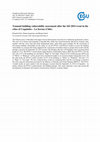
The Chilean coast is vulnerable to the impact of near-field tsunami events due to its subduction ... more The Chilean coast is vulnerable to the impact of near-field tsunami events due to its subduction geodynamic context. The cities of La Serena and Coquimbo (Coquimbo Bay, Chile) have been historically affected by tsunamis what, together with the scarce land and urban management plans, make them great examples for the assessment of the tsunami building vulnerability. In this study, we use the PTVA-3 and PTVA-4 models to assess the building vulnerability to a tsunami after being adapted to the construction of northern Chile to compare their results with the damages caused by the September 16, 2015 tsunami. The flooding affected 1,239 buildings with a maximum flood height of 3.5 m. The PTVA-3 model obtains higher Relative Vulnerability Indices (RVI) than the PTVA-4. For the first, only 5.5% of the buildings are classified as " High " or " Very high " whereas 63.6% of them present a RVI score of " Minor " or " Moderate " as they present lower inundation heights or are located at higher topographic levels. On the other hand, the PTVA-4 model classifies 83.5% of the buildings as " Minor " or " Moderate " and only 1.3% as " High " or " Very high ". We have evaluated these results by comparing them with the real damage occurred in the cities using the information provided by the Ministry of Housing and Urban Planning (MINVU). The PTVA-3 model results are more similar to the real damages occurred after the September 16, 2015 in Coquimbo – La Serena whereas the PTVA-4 underestimates the building damages. This study represents a first step towards the development of mitigation and response measurements related to a tsunami impact.
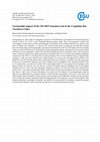
On September 16, 2105 a Mw 8.3 earthquake occurred at 22:55 GTM with a focal depth of 23 km and a... more On September 16, 2105 a Mw 8.3 earthquake occurred at 22:55 GTM with a focal depth of 23 km and an epicenter located 31.570 • S, W 71.670 • , in the Coquimbo Region (northern Chile). This event triggered a tsunami with wave heights of more than 6 m that caused damages and flooding in the northern Chilean coast, mainly in the cities of Tongoy and Coquimbo – La Serena. The vertical run-up shows an important saw-tooth like variation due to the sharp changes in the topography, specially towards both ends of the bay. The highest and more irregular values occurred in the South sector, that presents a higher topographic gradient, and progressively decrease towards the North were the topography is flatter. The horizontal flooding reached its maximum values in the bay fluvial valleys where the tsunami wave entered along the river channels. The waves, favored by the confining conditions, entered more than 950 m in the Elqui River mouth and almost 700 m in the Culebrón Stream. Coquimbo Bay comprises a wide and convex littoral zone of approximately 18 km long only interrupted by the mouths of the Elqui River and the Culebrón Stream where small saltmarshes have developed. According to the tide gauge data, the first wave reached the Coquimbo coast only 20 minutes after the earthquake with a maximum height of 0.85 m. 22 minutes later, a second wave arrived with a much higher height (4.3 m) causing the first damages on the littoral and the city. The last wave, the 4th one, occurred 35 minutes after the earthquake and was the highest reaching 4.68 m as well as the most damaging. Despite the existence of works that analyze the characteristics of this event, a more deep and thorough study is still needed of the tsunami geological record in the Coquimbo Bay where a wide variety of forms and deposits were preserved. The making of a geomorphological map has allowed us to differentiate the geological features related with the tsunamigenic event such as sand sheets and debris-boulder fields (tsunamites), littoral erosion scars developed on the saltmarshes, beaches and coastal dunes, erosive backwash channels, degraded wetlands, flooding lagoons or the appearance of new fluvial channels. This morpho-sedimentary assemblage, all together, has enabled us to characterize the conditions in which the tsunami occurred and to quantify it effects along this coastal zone as well their potential preservation.
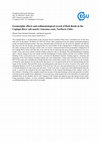
The Copiapó River is located South of the Atacama Desert (northern Chile) that is considered one ... more The Copiapó River is located South of the Atacama Desert (northern Chile) that is considered one of the most arid areas of the planet. On March 25 2015 this fluvial valley experienced one the largest hydrometeorological events recorded in historical times. The rain, unusually high, favored the run off in fluvial channels and alluvial fans that were dry for decades and triggered the rise and overflow of the Copiapó River at different points along the valley causing severe damages. In this work, we realize a characterization of the geomorphic configuration of the Copiapó River before and after this event with the aim of analyzing the main changes produced in the river mouth, where and extent coastal wetland of high ecological value is developed. The geomorphological mapping show a drastic change in the river mouth with the development of forms related with the river overflow and the flooding of the coastal plain such as levees, activation of abandoned channels, flooding lagoons, widening and deepening of the main channel, foredune rupture and, more importantly, a large mud sheet that covers almost the 80% of the study area, including the wetland and the main coastal dune systems. Just a small area of the wetland, far from the main channel, was not affected by this process as it was protected by the levees formed during the first stages of the overflow. The mud flow facies are homogeneous and consist of a layer of massive silty sands with a maximum thickness of 10-75 cm overlied by 5-20 cm of clay with wavy top and carbonaceous rest. It also presents a wide development of mud cracks and salt crusts. At the same time, 4 stages have been differentiated along the event: 1) arrival to the wetland of the first surge that flows in the channel and flooding of the southern sector of the wetland; 2) flooding of the complete mouth area because of the peak discharge arrival and generalize overflow with and associate muddy facies deposition; 3) erosional stage of the channel due to the formation of confined and turbulent flows in the channel; and 4) water logging of the wetland and adjacent areas that lasted several weeks. Using geostatistic technics, we have estimated a minimum volume of mud of 48,892 m3 (37,600 m3/km2) that accumulated during this event in the river mouth.
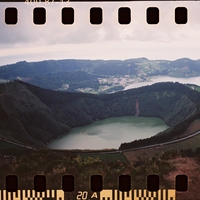




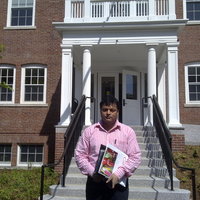
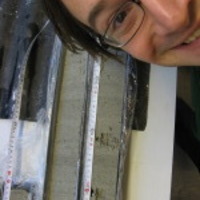

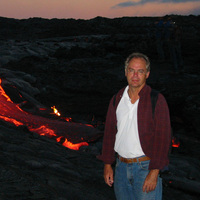
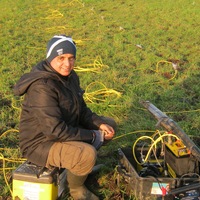
Uploads
Hydrogeology of volcanic islands by Tatiana Izquierdo
Sea-level and climate change by Tatiana Izquierdo
Volcanology by Tatiana Izquierdo
Risk assesment by Tatiana Izquierdo
Atacama (Chile). Las intensas lluvias causaron daños en varias ciudades de la Región de Atacama. La ciudad de
Copiapó se encuentra en la confluencia entre el Río Copiapó y Quebrada Paipote, un afluente seco en condiciones
climáticas normales. El proceso involucró un flujo de fango muy rápido (2,5 – 5,5 m/s) de alta densidad y viscosidad
que arrastró un gran volumen de arena y lutitas y enterró la ciudad bajo una capa de 31 cm de espesor medio. Un área
total de 12,2 km2 se inundó, el 72% de la zona urbana. Se han identificado cuatro sectores en los que se superaron los 2
m de inundación, con una medida máxima de 3,8 m cerca de la confluencia de los dos cauces y una inundación media
de 45 cm para toda la ciudad. El volumen de sedimento acumulado se estima aproximadamente en 2,2 millones m3 que
rellenaron casas, sótanos, alcantarillado, etc. Este evento pone de manifiesto la necesidad de elaborar mapas de
peligrosidad que combinados con análisis de vulnerabilidad permitan evaluar el riesgo de inundación de la ciudad.